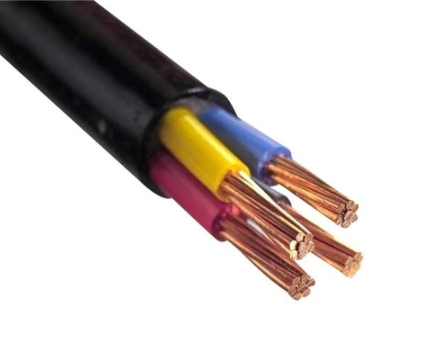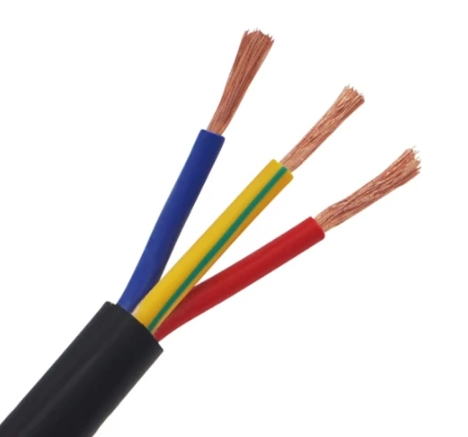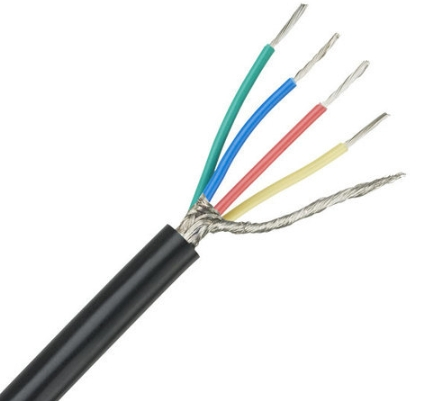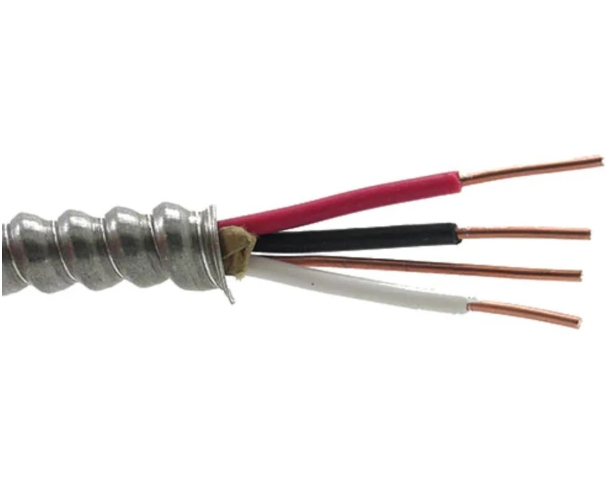Twisted pair cables are at the forefront of modern communication technology, serving as a critical backbone in a myriad of telecommunication and networking environments. This technology, seemingly simple in its construction, holds a profound significance in our daily communications, underpinning the vast majority of modern data and voice networks. The twisted pair cable, with its unique design of intertwined copper wires, has been ingeniously crafted to address some of the most persistent challenges in signal transmission. Its widespread adoption in various settings – from sprawling data centers to the familiar confines of home networks – speaks volumes about its versatility and effectiveness.
As we embark on a detailed exploration of twisted wire cables, we will uncover the intricacies of their types, the advantages and drawbacks they present, and delve into the science behind their distinctive design. we gain insights into why they have become an irreplaceable component in contemporary telecommunication infrastructures, adapting seamlessly to the ever-changing technological landscape. All while providing you with the optimal choice for your project!
What is twisted pair cable?
A twisted-pair cable is a type of cabling system widely used in telecommunications and networking applications. It is constructed with copper wires that are insulated in pairs and wound around one another. The twisting of the cable pairs is the main characteristic of this design, and it plays a crucial role in lowering crosstalk and electromagnetic interference (EMI), The insulation on each wire prevents electrical noise and minimizes the risk of signal degradation or loss.
This configuration makes twisted pair wires, particularly twisted pair Ethernet cables, highly efficient for transmitting data over both short and long distances. The simplicity of their construction, coupled with their effectiveness in maintaining signal integrity, has made twisted pair of wires a fundamental component in various communication systems. Next, let’s explore the different types available and their specific applications.
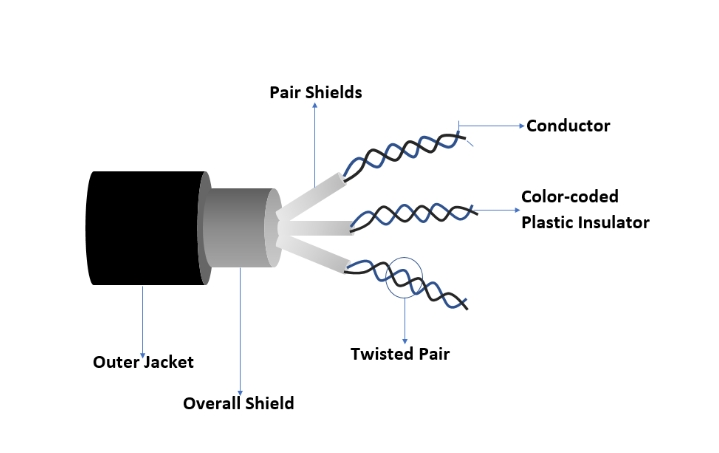
Types of Twisted Pair Cable
Twisted pair copper cables are categorized mainly into two types: Unshielded Twisted Pair (UTP) and Shielded Twisted Pair (STP).
Unshielded twisted pair is the more commonly used variant and is recognized by its lack of additional shielding. This makes UTP cables lighter, more flexible, and generally more cost-effective than their shielded counterparts. UTP cables are extensively used in residential and office environments for applications such as Ethernet networking, telephone lines, and basic data communications. They are available in various categories of twisted pair cable, like Cat5e, Cat6, and Cat7, each offering different levels of performance in terms of speed and bandwidth, catering to specific networking requirements. Both types are integral to modern networking and communication infrastructures, offering scalable and adaptable solutions to meet various data transmission requirements.
Shielded Twisted Pair wires, on the other hand, include an additional layer or layers of shielding, which provides extra protection against electromagnetic interference (EMI). This shielding can consist of foil, braiding, or a combination of both, surrounding each pair of wires or the entire cable. STP cables are ideal for environments with high levels of electrical noise or where there is a need for maintaining higher data transmission rates over longer distances. This makes them suitable for industrial applications, high-speed data centers, and environments where advanced security and signal integrity are paramount. So let’s delve into their advantages and disadvantages to fully grasp their impact on telecommunications and networking.
nothing found.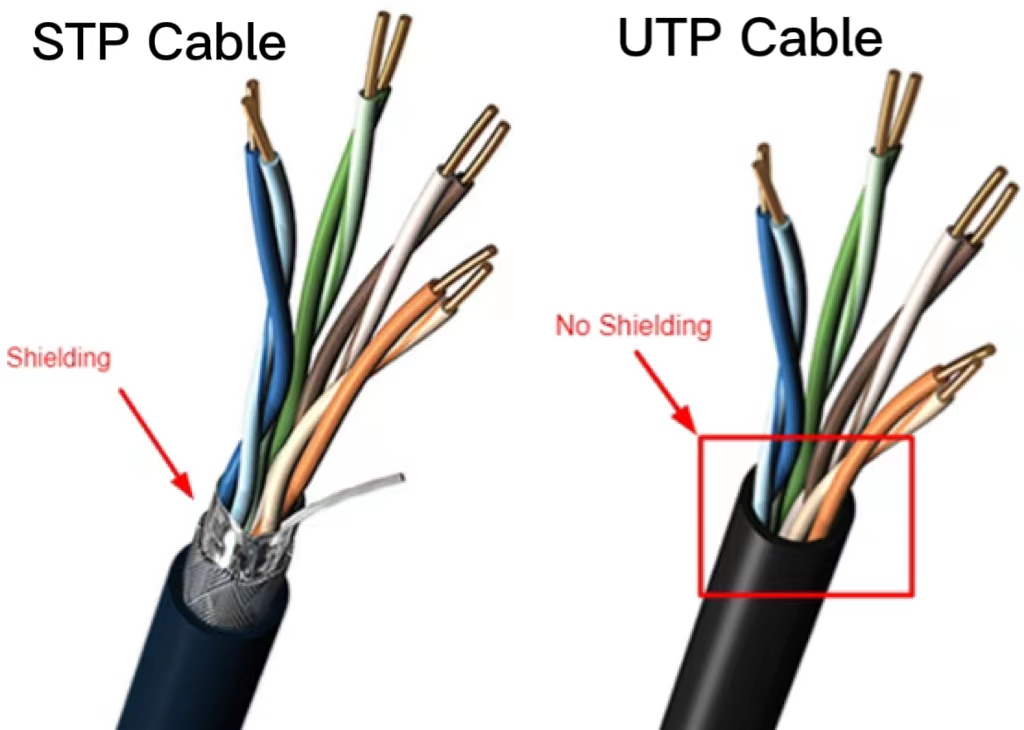
Twisted pair cable advantages and disadvantages
The advantages of twisted pair electrical cable are numerous in the realm of telecommunications and networking, yet it is important to acknowledge its significant drawbacks:
Advantages:
Flexibility: Twisted cables, including twisted speaker wire, offer high flexibility, easing installation in complex environments. This flexibility is particularly beneficial in complex networking environments.
Cost-Effectiveness: Shielded twisted pair cables are generally more affordable than other types of cabling like fiber optic or coaxial cables.
Reduced Crosstalk and Interference: The twisting of the wires in the cable helps to cancel out electromagnetic interference from external sources and crosstalk between adjacent cables, leading to clearer signal transmission.
Widespread Availability and Compatibility: Twisted Stranded Core Wires are widely available and compatible with a vast array of network equipment and connectors. This universal compatibility simplifies network design and expansion.
Support for Various Networking Standards: Twisted wire cables support a range of networking standards and are suitable for various applications, from telephone lines to high-speed data networks.
Disadvantages:
Susceptibility to Interference: While twisted pair electrical wires reduce interference, unshielded variants can still be susceptible to electromagnetic interference, impacting data cable transmission quality.
Distance Limitations: Twisted pair cables have limitations in terms of the distance they can effectively carry a signal without degradation. Signal boosters or repeaters may be needed for longer runs.
Physical Vulnerability: When comparing coaxial vs. twisted pair cables in terms of durability and physical ruggedness, it is clear that twisted pair copper cables are typically not as rugged as coaxial or fiber optic cables and can be more vulnerable to damage from bending or crushing.
Shielding Requirements for STP: Shielded Twisted Pair (STP) cables, while offering better protection against EMI, are more expensive and less flexible than Unshielded Twisted Pair (UTP) cables.
In summary, twisted pair cables are a versatile and cost-effective solution for many networking needs, but they do have limitations in terms of interference susceptibility, distance, and bandwidth compared to other cabling options. This leads us to the fundamental question of why the wires in these cables are twisted. Let’s explore the purpose and mechanics behind this unique design.
What is the purpose of twists in a twisted pair cable?
The twists in a twisted pair cable play a crucial role in enhancing performance by reducing electromagnetic interference (EMI) and crosstalk. Here’s a more detailed look at the role of these twists:
- Reducing Electromagnetic Interference: Electromagnetic interference (EMI) can be a significant issue in cable transmission, particularly in environments with a lot of electronic devices. In twisted braided cables, the act of twisting the wires together helps to counteract EMI. This is because both wires in a pair are affected equally by external electromagnetic fields. Since the signals transmitted by these wires are in anti-phase with each other, any interference can be effectively eliminated. This feature is particularly beneficial in areas with high levels of electrical noise, ensuring a more stable and clearer signal transmission.
- Minimizing Crosstalk: Crosstalk occurs when the signal from one circuit or channel spills over into another, potentially causing confusion and signal disruption. In a twisted wire, the twisting of the wires helps to minimize this effect. Each twist in the wires lays them next to a slightly different part of the adjacent pair along the length of the cable. This constant changing of proximity means that any crosstalk from one pair to another is averaged out over the length of the cable, greatly reducing the overall impact.
The number of twists per meter can vary in different types of twisted pair cables, including options like 22 awg twisted pair shielded cable and 16 gauge twisted pair wire. This variation is typically optimized based on the cable’s intended use, ensuring that each design meets specific performance criteria and environmental conditions effectively. For instance, cables designed for higher-frequency signals might have more twists per meter to provide better protection against interference. The precise engineering of these twists is a key aspect of the cable’s design and is instrumental in ensuring reliable and high-quality signal transmission. Now, let’s address the underlying reason behind the twisting of the wires, which is central to the functionality and effectiveness of these cables.
Why are the wires twisted around each other in twisted pair cables?
Twisted cables utilize a design where wires are intricately twisted around each other, primarily to reduce electromagnetic interference (EMI). This interference, stemming from various electronic sources, is a significant concern in cable transmission. The twisting arrangement ensures that any EMI affecting one wire is counteracted by its partner, as both wires experience interference similarly and oppositely. This design effectively neutralizes external noise, enhancing signal clarity.
Additionally, this twisting helps mitigate crosstalk – the unwanted transfer of signals between communication channels. Crosstalk is reduced because the twists cause each wire to be equally exposed to any potential interference from adjacent pairs. This equal exposure, due to the twists, leads to the cancellation of interfering signals, maintaining the integrity of the transmission. This simple yet effective technique is key to the reliability and effectiveness of twisted pair cabling in telecommunications and data networking.
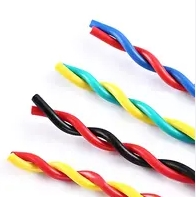
Conclusion
In conclusion, twisted pair wires represent a pivotal innovation in telecommunications and networking infrastructure. Their unique design, featuring pairs of wires intricately twisted around each other, adeptly addresses critical challenges such as electromagnetic interference and crosstalk. This design not only enhances signal quality but also makes these cables a versatile and cost-effective solution for a wide range of applications. From residential internet connections to complex data center networks, twisted paired cables have proven to be an indispensable component, ensuring reliable and efficient communication across various platforms.
At the forefront of embracing and advancing this technology, ZW Cable, a leader in the cable manufacturing industry, specializes in producing top-notch screened cable twisted pairs that combine innovation with quality to meet the evolving needs of modern connectivity. Our twisted pair solutions are known for their durability, performance, and strict industry standards for a wide range of applications. Whether in commercial settings, industrial environments or house wire installations, ZW cable is synonymous with reliability and excellence in your projects!
FAQs
Why is STP more expensive than UTP?
STP cables are designed with an additional layer of shielding. This additional layer is critical to provide protection against electromagnetic interference, which can seriously affect signal quality. However, adding a shield to STP cables has several drawbacks. First, it increases the cost of these cables, making them a more expensive option than unshielded cables. In addition, the extra shielding leads to increased weight.
What is the difference between twisted pair and fiber?
Fiber optic cables are the best choice for high-speed, long-distance communications. They can transmit large amounts of data over long distances without significant loss.
On the other hand, twisted-pair cables are widely used for LAN applications and other short-distance networking needs because of their cost-effectiveness and simplicity.


